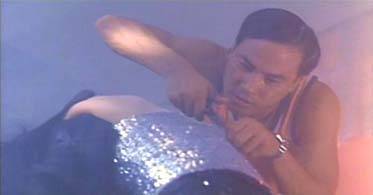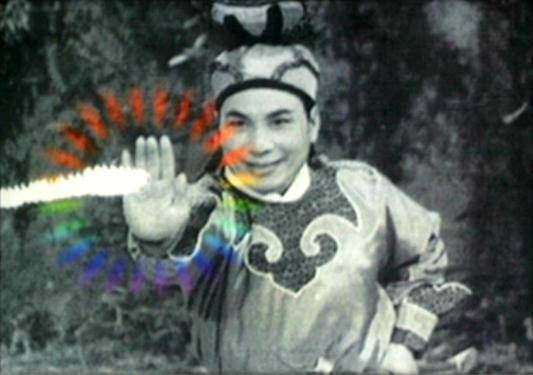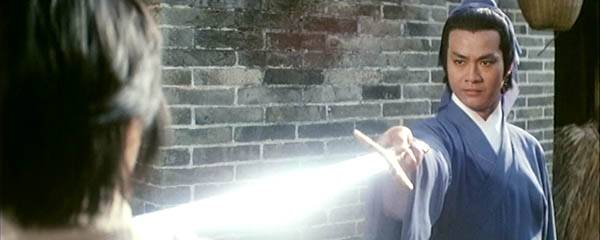|
| Trend or genre? |
 HKCinemagic: Talk about film genres specific to the Hong Kong cinema. HKCinemagic: Talk about film genres specific to the Hong Kong cinema. |
| Law Kar: How do we define ‘genre’ in the Chinese sense? In the HK and in the Chinese language cinema, there is always that kind of discussion and argument, even between friends and critics from HK.
You are used to the western sense of ‘genre’, like horror films, action, comedy, epics, that kind of things. But in HK, we don’t have many epics. For comedies, we have several kinds, like ‘mo lei tau’, non-sensical comedies. In action films, one time we have heroic bloodshed, another time detective films, so it is really confusing in Chinese terms.
Sometimes we take a trend for a genre. Like heroic bloodshed, which is in fact a trend rather than a genre. It’s under the action genre or the gangster genre, and it is a trend. The trend started with John Woo’s A Better Tomorrow (1986). For a few years, we had many many heroic bloodshed films. Sometimes it’s just gangsters films, but more violent in some fight scenes. Some of them are not so violent. But for several years, even here in HK we called them all heroic bloodshed films. They went out of trend and changed into detective films.

Ti Lung, Dean Shek and Chow Yun-fat in A Better Tomorrow 2
In fact, those are trends.
The main genre we have is the ‘wu xia pian’ (Chinese chivalry movie) or ‘martial art films’ that include wuxia and kung fu. I think ‘martial arts’ is a more reasonable name for this genre, it is a western name. But the martial arts films include swords fighting (fighting with weapons) and fighting bare hands, like in kung fu films.
In fact there are many film genres in the HK [film scene at any given] time. The HK filmmakers do not look at genres from the Western angle. They tend more to define their films with trends rather than genres.
So this time we have kung fu films. In fact we have always had martial arts films, even in the 1930s, 1940s and the 1950s. Even now we have kung fu films but you can see they are set in contemporary settings. But for the filmmakers and the HK people, when they speak of HK kung fu films they speak of these years of Bruce Lee, the early 1970s. It last for only a few years. And later we called contemporary martial arts film ‘action films,’ no more kung fu films. So they use the term [kung fu film] more like a trend rather than a genre.

Jimmy Wang Yu in Return of the One-armed Swordsman
The two main genres or trends that are still lasting are wuxia pian or martial arts films and comedy. Those are two main genres from the 1960s on when you speak of Hong Kong cinema.
You can mix them and create other genres like the kung fu comedy, like the modern action films or like Jackie Chan’s films. They are in fact kung fu films and comical kung fu films in a modern setting.
Apart from martial arts films and comedies, we have some specialties. We have a kind of musical and before that we had ‘wenyi pian,’ which was kind of opposite to wuxia pian. In China, you have two opposite notions, 'wen' and 'wu,' that is 'literary' and 'martial.' They’re like ying and yang. In a very broad sense, wenyi pian are ‘literary’ films. In fact it includes realistic films, love stories, social films; those films without a lot of action. For the literary category you have social critical films, romance, light comedy, different musicals. For the martial category, you have kung fu, swordplay and even some kind of opera films, and modern action films. |
| |
 HKCinemagic: What about the huangmei diao opera films? HKCinemagic: What about the huangmei diao opera films? |
| Law Kar: Huangmei diao belongs to the wen side. |
| |
| Mixed bag of genres |
 HKCinemagic: In HK, it is rather typical to mix all genres or trends in one single movie, like a film starts as a serious detective film, before showing signs of non-sensical comedy and finally it becomes a drama. Why is there such a mix in HK films? HKCinemagic: In HK, it is rather typical to mix all genres or trends in one single movie, like a film starts as a serious detective film, before showing signs of non-sensical comedy and finally it becomes a drama. Why is there such a mix in HK films? |
| Law Kar: I think it’s because HK is a kind of free pot open to all kind of influences from all around the world. It’s the Hong Kong condition; we are good at shopping [ideas] around and get influences from all around the world and create something quite local with it. You can see the sources, but still it feels that it’s something from HK. Maybe that’s what is interesting. And sometimes that is being criticized as second hand because that’s not really original. Because we don’t have a strong culture, we don’t have a nationality, you know, being dominated by this country [the UK] in the past and this kind of culture. So what is so interesting with HK cinema is everything is mixed up, a conglomeration of something from here and there. You can see influences from every country. |
| |
| OTHER TRENDS |
 HKCinemagic: Huangmei diao films were popular in HK and all over Asia. Can we consider this an important trend in the HK cinema history, even if the huangmei diao craze only last a few years? HKCinemagic: Huangmei diao films were popular in HK and all over Asia. Can we consider this an important trend in the HK cinema history, even if the huangmei diao craze only last a few years? |
| Law Kar: I don’t know if people outside the Chinese language territories liked it or not.
But in China and HK and Taiwan they liked it like crazy for some years. Since it is all singing, not dancing nor action, it is not so internationally known or recognized. It is a folk art, really a refined art form, like Beijing Opera. |
| |
 HKCinemagic: Let’s talk about another genre from the list I gave you: The Category III films. HKCinemagic: Let’s talk about another genre from the list I gave you: The Category III films. |
| Law Kar: Category III films is so to speak soft porn and soft core. It was popular for only some years. Now it is so easy to get more explicit films, even category 4 or 5 films, available on DVDs around the world, you know. Category III films exist no more. Nobody go to the theatre to see these films, instead they can buy more DVD and watch at home. It is more private and they enjoy more. |
| |

A Category III film: Dr. Lamb with Simon Yam
|
| |
| COMEDIES, MOLEITAU |
 HKCinemagic: I understand that non-sensical comedies, or "moleitau” are huge in HK. HKCinemagic: I understand that non-sensical comedies, or "moleitau” are huge in HK. |
| As for non-sensical comedies, it is also a trend. A form of comedy that has been pushed to the extreme. They used some non-sensical dialogues and action concerning the critical scene and the social scene of HK to elicit a reaction from the audience. Because people [making these films] didn’t believe in communication between HK and Beijing and didn’t believe in language. So, instead they played with language. “If our leaders can play with words, we can too. Interestingly, our plays on words are more sensical than yours.” If you relate Stephen Chow’s comedies to the political and social events at the time you’ll see more. Sometimes these films are not so non-sensical, sometimes they are quite sensical. They are a kind of a reaction, a protest against the reality. |
| |
 HKCinemagic: This trend started with the Hui brothers in the 1970s I believe. HKCinemagic: This trend started with the Hui brothers in the 1970s I believe. |
The Hui brothers’ form of protest and their kind of absurdity were not as strong as Stephen Chow’s.
|
| |
 HKCinemagic: But it was the beginning; they tried to address social issues. HKCinemagic: But it was the beginning; they tried to address social issues. |
| Law Kar: Yes. Even in the mid to late 1960s, this kind of comedies had started to be popular. They used daily situations to parodied or satirized the government or power groups or some phenomena. And later, Stephen Chow pushed it to the extreme, towards the non-sensical [extreme]. |
| |
 HKCinemagic: So can we say that this trend is political? It’s surprising… HKCinemagic: So can we say that this trend is political? It’s surprising… |
| Law Kar: Yes, political, but never looked like this by people. Audiences just enjoy it. And they find a kind of sympathy [toward the film] because they didn’t know they were being bothered by the political leaders or those activities. And they loved it because there is some kind of need to act against a power group or the government or the political power. With the films of Stephen Chow, moviegoers found an outlet for their anger and their protest, although they didn’t know it themselves. |
| |
 HKCinemagic: It is a well-known fact that HK movies are not political… HKCinemagic: It is a well-known fact that HK movies are not political… |
| Law Kar: They aren’t directly political. They are political more in an allegory form; it’s not like “Z” by Costa-Gavras, that kind of political film. Sure. HK filmmakers don’t target one issue and try to push this issue to a wider awareness. They kind of unconsciously get people involved and aware of the situation. And at the same time their films entertain the people and let them have their outlet for their anger or protest. |
| |
| WU XIA PIAN |
 HKCinemagic: Let’s review the evolution of the wuxiapian genre over the last century. HKCinemagic: Let’s review the evolution of the wuxiapian genre over the last century. |
Law Kar: In HK and in China, we mainly use the wuxiapian terms [for these films]. We first used it in the 1920s, when films like the The Burning of the Red Lotus Temple (Zhang Shi Chuan, 1928). And those are films played with costumes, set in Ancient China and they use weapons like swords or knives, you know, that kind of fighting. And these films tell stories of people who know martial arts or use their skills to do some chivalrous things, action, to save the oppressed people, uphold the justice, or to repay some good acts from others, to assassin a dictator. In short, to do something for the people, for justice.
At that time, that kind of films was called “wuxiapian.” Later, because of strong conditions, that kind of films degenerated into more fantastic films. These swordsmen not only had swords but some kind of super human power. They used swords that flew in the air and killed people from miles away. They used palm power. Filmmakers created a lot of gadgets to please the audience. That was because the competition [between production companies] was going stronger and stronger. It is no more martial arts. It is far away from martial arts. It’s just being fantastic. That was also included in the wuxiapian category at that time. We called it “fantastic wuxiapian.” And this kind of traditions being revived or recreated in HK after the 1950s is exactly the same things filmmakers did in Shanghai [in the 1920s]. Only, the special visual effects were improved with better animation, adding color, the wiring, the flying, making these kinds of things more surprising.
In the early 1960s, we revived this kind of [film] tradition from the 1920s Shanghai and created another trend of fantastic martial arts integrating a lot of handcrafted special effects.

Buddha’s Palm, a special effect-laden wuxiapian
Then from the mid 1960s, Run Run Shaw, Chang Cheh and others tried to explore other directions. They tried to create another trend by doing more realistic wuxiapian. More realistic but also more violent. It was not only fights with palm power and flying swords, people were fighting and they were really dying. We could see they were dying under the sword. What’s more the films were more based on human relationships. They were not only hero figures, they had their painful moments, they had their psychological intentions and depth in those films. So it was more realistic in that sense. It was more realistic in terms of the fighting scenes, the human nature, the [character] relationships. So these films are different from those fantastic ones [before] that used a lot of gadgets. And this trend had proven to be very successful for more than ten years, with The One-Armed Swordsman and the likes.
And then in the early 1970s, the Bruce Lee’s kung fu films created another trend.
And then in the late 1970s the “new wave” appeared with films like Patrick Tam’s The Sword and Tsui Hark’s Butterfly Murders. Both are early new wave films. The [respective directors] tried to absorb the influence from Japanese films and from European films and put it into that kind of Chinese genre to create something that was more surprising. What we call new wave is for instance in the Patrick Tam’s film you can feel the influence of Jean-Pierre Melville. They’ve got conflicts in static and in dynamic moments. Hong Kong directors started using this kind of tempo, this kind of technique into locally made wuxiapian. So you can see it’s quite new to them. They try to control the static and the dynamic moments, this tempo is quite an European thing. Also, like in Tsui Hark’s Butterfly Murders, directors tried to incorporate sci-fi from the West and some influence from Japanese Manga, they put in it this kind of futuristic thing. It’s not just traditional wuxiapian. That’s what we called “new wave martial arts films” or “maybe new wave wuxiapian.”
|

Patrick Tam’s The Sword, starring Adam Cheng
|
|
|
